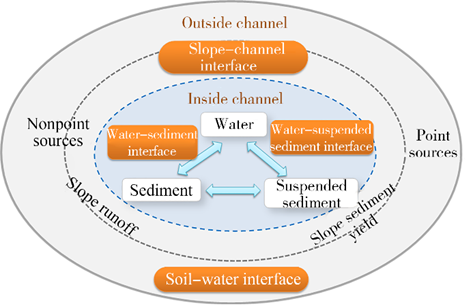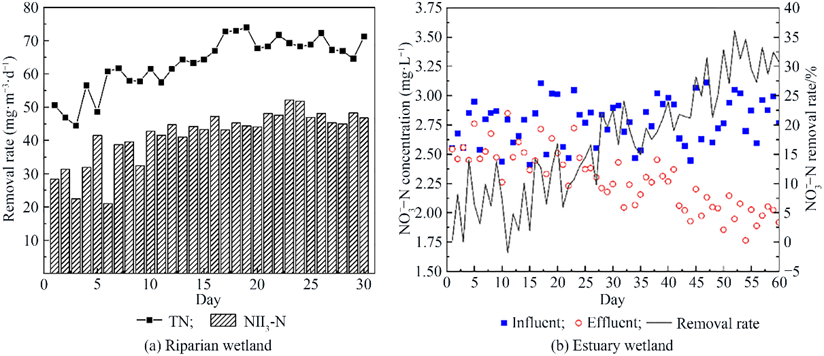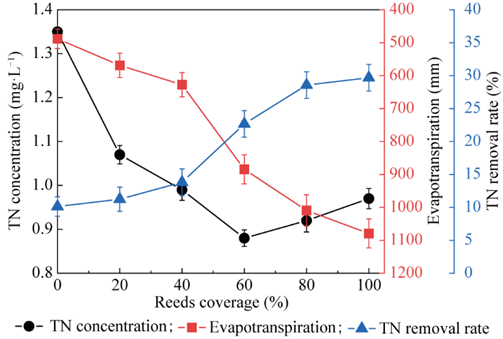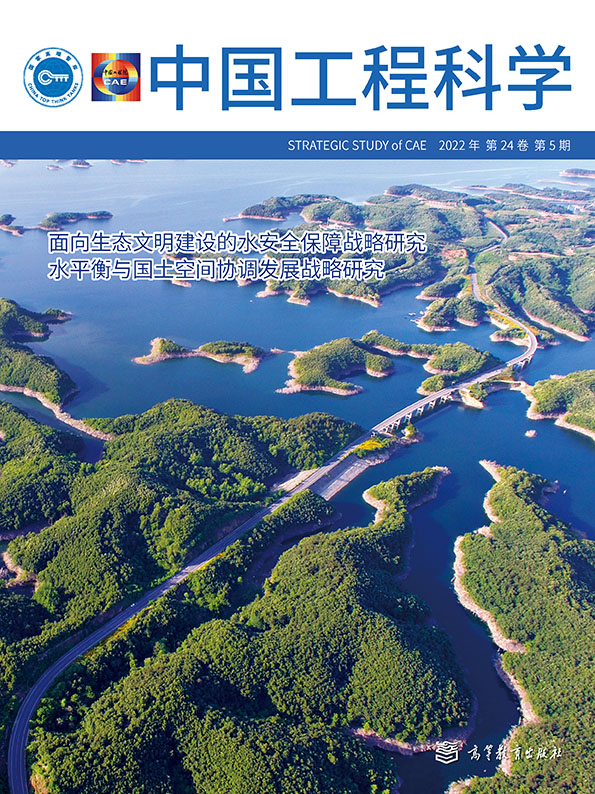《1 Introduction》
1 Introduction
Water and soil resources are the material basis of human survival and the fundamental guarantee of national water and food security. The spatial and temporal distributions of water and soil resources in China are uneven. The population, cultivated area, and gross domestic product of the northern region of China account for 46%, 60%, and 45% of the national amounts, respectively. However, the gross water resources of this region only account for 19% of the national amount, and most of the precipitation is concentrated in the flood seasons of summer and autumn, accounting for approximately 60% to 80% of the annual precipitation. The water and soil pollution situation in China is still severe. The first national soil pollution survey showed that 19.4% of the cultivated soil points exceeded the standard. Among the 775 soil points in 81 industrial wastelands, 34.9% of the points exceeded the standard [1]. The total sewage discharge in China has exceeded 1.3 × 1012 m3 since the beginning of statistics, approximately 50% of the total water resources in the country [2], which has led to a series of ecological and environmental problems, resulting in environmental and human health risks. Therefore, water and soil pollution control and treatment are still major environmental problems to be urgently solved.
Studies have shown that there are complex source–sink relationships of pollutants in water and soil environments [3–7]. The pollutants in water may mainly come from soil and the pollutants in water may also enter soil. Therefore, the water environment cannot be separated from the soil environment for pollution control and treatment. Instead, it is necessary to study the water and soil environments in watersheds as a whole and propose the principles, methods, and technologies of cross-medium regulation in water and soil environments (including plants, animals, and microorganisms). It mainly includes cross-medium attribution identification of water and soil environmental pollution in watersheds and the principles, methods, and technologies of cross-medium treatment. Therefore, the integrated control of water and soil environmental pollution in watersheds can be realized.
The regulation and control of pollutants across the water–soil medium in the water and soil environments of watersheds includes the cross-medium regulation and control of water–soil and slope–channels outside river channels, as well as the water–sediment and water–suspended particulate matter interfaces in river channels. Therefore, based on the analysis of the cross-medium transformation of pollutants in the water and soil environments of watersheds, this paper emphasizes the important role of various water–soil interface processes in the cross-medium removal of pollutants. Finally, practical cases are used to describe the cross-medium control of nonpoint source pollutants, the cross-medium removal of nitrogen-containing compounds from rivers, and the cross-medium removal of nitrogen and phosphorus from lakes. It provides a scientific basis for the control and treatment of water and soil environmental pollution.
《2 Cross-medium transfer process of pollutants in the water and soil environments in watersheds》
2 Cross-medium transfer process of pollutants in the water and soil environments in watersheds
There are complex source-sink relationships of pollutants in water, soil, and atmospheric environments (Fig.1). Pollutants can directly discharge into the atmosphere, water, and soil through human activities. For example, polycyclic aromatic hydrocarbons (PAHs) can directly discharge into the atmosphere by burning various fossil fuels, sewage generated by factories may directly discharge into rivers or lakes, and fertilizers and pesticides used in agricultural production may directly enter the soil. Meanwhile, these pollutants entering the environment from different sources will transfer and transform in multiple media of water, soil, and atmosphere. For example, the PAHs in the atmosphere can enter the soil and water environments through dry and wet deposition, and the PAHs in soil and water can also enter the atmosphere again through volatilization. Pollutants can transfer from water to soil by irrigating arable land with water from polluted rivers and lakes. In turn, nitrogen, phosphorus, pesticides, and other pollutants in farming soil can enter receiving waters through surface runoff. The results of the first national survey of pollution sources showed that total nitrogen (TN) and total phosphorus (TP) from agricultural nonpoint sources alone accounted for 57.2% and 67.4% of total emissions, respectively, exceeding industrial pollution [8]. Therefore, approximately 50% of nitrogen and phosphorus in the rivers of China come from agricultural nonpoint source pollution. After transfer among water, soil, and atmosphere, the contents and forms of pollutants in different media will directly affect the process of biodegradation and transformation, as well as the concentration in organisms, including various terrestrial and aquatic plants and animals, which will further bring risks to the environment and human health.
《Fig.1》

Fig.1. Cross-medium migration of pollutants in the water and soil environments of watershed.
More volatile pollutants (such as PAHs and other organic pollutants) are transferred in three phases among the water-soil-atmosphere, while less volatile pollutants (such as heavy metals, nitrate and phosphorus) are mainly transferred in the water and soil environments. The cross-medium transfer of pollutants in the water and soil environments at a catchment in this paper mainly refers to the transfer of pollutants in two phases between water and soil (including organisms in soil). The transfer of pollutants in water–soil medium and various media is affected not only by the physical and chemical properties of pollutants but also by the environment and hydrological conditions. Water is an important carrier of pollutants and sediment transport. Therefore, hydrological conditions are important factors affecting the transfer of pollutants in soil and water environments. Pollutants can be carried directly from the soil environment outside the river channel into the water environment in river channels by surface runoff caused by rainfall. Moreover, there are significant differences in the scour effects of different rainfall intensities on pollutants. Studies have shown that extreme rainfall caused by climate change washes a large amount of pollutants from the soil environment into waters in a short time, resulting in increased concentrations of nitrogen and phosphorus in water and further triggering algal blooms under the effect of warming [9]. In addition, the hydrodynamic conditions of rivers and lakes will affect the resuspension and sedimentation of sediments and then affect the transfer of pollutants in water. Hydrodynamic conditions also affect the transport of pollutants downstream and into estuaries.
《3 Cross-medium attribution identification of water and soil environmental pollution in watersheds》
3 Cross-medium attribution identification of water and soil environmental pollution in watersheds
Pollutants transfer and transform in the water and soil environments at a catchment, and the monitored water and soil environmental pollution situation is only the result of pollutant transfer and transformation in the water and soil environments. To control water and soil environmental pollution, it is necessary to trace the source of water and soil environmental pollutants, control them from the source, and find the real pollution source through cross-medium attribution identification.
In addition to domestic sewage and industrial wastewater, another major source of nitrogen pollution in rivers is soil, including synthetic fertilizers, livestock, and poultry manure and soil organic nitrogen that enter rivers through soil surface runoff [10]. The isotope method is generally used to analyze the source of river nitrogen pollution because different sources of nitrogen have different nitrogen and oxygen isotope characteristic values of δ15N, δ17O, and δ18O. The study of nitrogen pollution in the middle and lower reaches of the Yellow River showed that the nitrate in the river is mainly from the discharge of domestic sewage and nitrification products of ammonia/urea fertilizer. The contributions of the two are similar, which is consistent with the dense cities and the abundant agricultural land. In addition to terrestrial sources, atmospheric nitrogen deposition is also a nonnegligible source of river nitrogen. In particular, the proportion of atmospheric nitrogen deposition is relatively large in areas that are less affected by human activities. For example, atmospheric nitrogen deposition accounts for only 0–7% of the nitrate sources in the middle and lower reaches of the Yellow River; however, it accounts for 9.5% of the nitrate sources in the source region of the Yellow River [10–11].
The transfer and transformation of pollutants between the soil and water environments in urban areas are more complex. Urban domestic sewage, industrial wastewater, and hospital wastewater after certain treatments enter urban sewage treatment plants for centralized treatment. The generated tailwater is used as recycled water to recharge urban rivers and lakes or for urban greening water. Therefore, the residual pollutants in the tailwater of sewage treatment plants directly affect the water quality of urban rivers and lakes and the soil environment of green spaces. In addition, pollutants in urban soil enter urban rivers and lakes and drinking water sources through surface runoff. Therefore, for the cross-medium attribution identification of water and soil environmental pollutants in urban areas, it is necessary to analyze not only how much of the pollutants in urban waters come from surface runoff (nonpoint source) but also how much of the pollutants come from point source discharge, such as hospital and industrial wastewater.
Studies have shown that the content of pharmaceutical and personal care products (PPCPs) in urban water and soil environments is high [12–14]. The cross-medium attribution identification studies showed that the PPCP concentrations in the effluent of urban sewage treatment plants were similar to the influent concentration owing to the low PPCP removal ability of conventional urban sewage treatment processes. This pollutes urban rivers, lakes, and soil and accumulates to a relatively high concentration of PPCPs year to year. Further investigation of the source of pollution revealed that the concentration of 22 typical psychiatric drugs in three categories in the drainage of two psychiatric hospitals and the concentration of tetracycline in the drainage of wastewater treatment plants of tetracycline manufacturing enterprises in northern and southern Beijing were much higher than the concentration of PPCPs in the drainage of the three largest urban sewage treatment plants in Beijing [15]. These results suggest that centralized discharge sources of PPCPs, such as external drainage from hospitals and PPCP production enterprises, are the main sources of PPCPs and the key to controlling PPCP pollution in urban water and soil environments.
《4 Cross-medium control of water and soil environmental pollution in watersheds》
4 Cross-medium control of water and soil environmental pollution in watersheds
《4.1 The role of pollutant water–soil interface processes in cross-medium control》
4.1 The role of pollutant water–soil interface processes in cross-medium control
Transfer and transformation of pollutants in the water and soil environments at a catchment are mainly controlled by various water–soil interface processes. The water–soil interfaces include soil–water and slope–channel interfaces (including the path by which substances flow into rivers through surface runoff) outside river channels, as well as water–sediment (including water solid interfaces in the riverbed and lateral shore hyporheic zone) and water–suspended particulate matter interfaces inside river channels (Fig.2). Organic and inorganic pollutants in the soil environment have various physicochemical and biological reactions, such as adsorption, desorption, redox, biodegradation or biotransformation, in soil–water interfaces, which directly affect the forms and bioavailability of pollutants. Different forms of pollutants have different difficulties entering river channels under surface runoff. The adsorption, interception, and degradation of pollutants at slope–channel interfaces can also control the amount of pollutants entering rivers. In addition, the pollutants entering river channels can biodegrade and transform at water–solid interfaces (including sediment and suspended particulate matters). Studies have shown that nitrogen-containing compounds and toxic organic pollutants mainly biodegrade and mineralize at water–solid interfaces [16–19]. The interfacial processes mentioned above in rivers are also applicable to lakes.
《Fig. 2》

Fig. 2. Schematic diagram of water and soil interface in watershed.
Water and soil environmental pollution need to be controlled by artificially regulating or strengthening interface processes on the basis of cross-medium attribution identification. For example, the first way to control nitrogen and phosphorus pollution in rivers and lakes is to control the source. The nonpoint source of nitrogen and phosphorus from farmland is one of the main sources for nitrogen and phosphorus in rivers and lakes. Therefore, it is necessary to regulate the soil–water and slope–channel interface processes of nitrogen and phosphorus to reduce the nitrogen and phosphorus from farmland to rivers and lakes. Many nonpoint source pollution control projects are based on these interface processes. For pollutants that have entered rivers or lakes, various interface processes in waters need to be utilized and strengthened to remove pollutants or reduce bioavailability.
《4.2 Slope–channel interface regulation of pollutants in watersheds》
4.2 Slope–channel interface regulation of pollutants in watersheds
The main measures to reduce pollutants, such as nitrogen, phosphorus, and pesticides, from outside river channels into river channels include source control, transfer path interception, and pipe-end treatment. The latter two are mainly to reduce surface runoff and intercept pollutants by controlling measurements of the slope–channel interface, reducing the amount of pollutants in rivers. Using the Xiangxi River Basin in the Three Gorges Reservoir area as an example and based on the results of previous SWAT model simulations, the control effect of the best management measures on nonpoint source pollution was discussed from three aspects: source control, transfer path interception, and pipe-end treatment. The results showed that when fertilizer use is reduced to 50% of conventional fertilization in the process of source control, the TN and TP production of nonpoint source pollution can be reduced to 72% and 65% of conventional fertilization, respectively. The production of nonpoint source pollution in watersheds can be effectively reduced by converting arable land to forest with a slope greater than 15° and implementing tillage management for arable land with a slope less than 15°. Runoff was reduced by 16% and 9%, TN production was reduced by 9% and 8%, and TP production was reduced by 7% and 5% by conservation tillage and contour cropping, respectively [20]. In transfer pathways and pipe-end treatments, vegetative filter strips are recommended by the Natural Resources Conservation Service of the United States Department of Agriculture for process blocking of nonpoint source pollutants [21]. Vegetative filter strips can lead to the settlement of soil particles by slowing the slope overflow velocity, thus removing pollutants. It can also increase regional infiltration and reduce surface runoff and nonparticulate pollutants [22]. However, the construction methods of filter strips and pollution interception capacity are different in different study areas owing to the various influences of topography, climate and other factors. The northern vegetative filter strip was more obvious in nitrogen and phosphorus interception when compared with that in the southern strip [23]. Planting grass in field and river channels is also an effective project management measure. Studies have shown that the TN and TP loads in the outlet of the river channel after grass planting in the field in the Xiangxi River Basin of the Three Gorges Reservoir area can be reduced by 16.7% and 34%, respectively. Therefore, from the perspective of the control effect, grass-covered river channels can effectively control agricultural nonpoint source pollution, especially TP pollution [24].
《4.3 Cross-medium removal of nitrogen-containing compounds from rivers》
4.3 Cross-medium removal of nitrogen-containing compounds from rivers
Rivers are important channels that connect land with other waters. Nitrogen, phosphorus and other pollutants that flow into rivers from land can be transported to lakes, reservoirs, and oceans. Organic pollutants, such as pesticides, that have entered rivers can be removed by degradation, and nitrogen-containing compounds are mainly removed by denitrification. The potential of nitrogen removal in rivers is related to nitrogen forms and water environment conditions. Nitrogen removal mainly occurs in the hyporheic zone of the riverbed and lateral shore and suspended sediment matter–water interface [25–27], and nitrogen removal in water is very small. Although nitrogen-containing compounds mainly exist in water, they can be removed to sedimentary facies of the hyporheic zone or lateral shore hyporheic zones by cross-medium transfer.
For rivers with low oxygen and high ammonium nitrogen, riverside wetlands can be constructed by riparian zones, and in situ autotrophic nitrogen removal can be achieved by lateral hyporheic exchange. In the constructed strip-like wetland system, there is an inner zeolite layer to adsorb ammonium nitrogen. The anaerobic ammonium oxidation (anammox) bacteria were gathered in the zeolite layer under conditions of low dissolved oxygen (0.87–1.60 mg/L), and ammonium nitrogen was removed by anammox. Driven by this enhanced nitrogen removal, the average removal rates of NH3-N and TN were 41.6 mg·m−3·d−1 and 63.2 mg·m−3·d−1, respectively (Fig. 3). The method can achieve cross-medium removal of ammonium nitrogen by transferring ammonium nitrogen from water to the inner zeolite layer for nitrogen removal [28–29].
《Fig.3》

Fig.3. Nitrogen removal efficiency of new riparian wetland and estuary wetland purification technology
For rivers with low carbon and high nitrate, a riparian wetland was constructed in a river bend to study the effect of the addition of Bacillus subtilis FY99-01 on nitrate removal. The results showed that owing to the integrated hydraulic and microbial effects, the maximal nitrate removal and the mean nitrate loss rate were 36.1% and 50.5 g·m-2·yr-1, respectively (Fig. 3). Nitrate was removed more efficiently in the summer than in the winter, and the redox potential was very significant for denitrification. This method can remove nitrate by transferring nitrate from rivers to riparian wetlands.
《4.4 Cross-medium removal of nitrogen and phosphorus from lakes》
4.4 Cross-medium removal of nitrogen and phosphorus from lakes
Many lakes in China have excessive nitrogen and phosphorus contents. Nitrogen and phosphorus nutrients can be absorbed by planting aquatic plants, such as reeds, and then harvesting aquatic plants to achieve the cross-medium removal of nitrogen and phosphorus in waters. For example, a study on the characteristics of nitrogen and phosphorus and the growth of reeds in Baiyangdian Lake showed that the growth of reeds and their absorption of nutrients were significantly correlated with changes in the water level and nutrient load, respectively (p<0.05) [30]. The comprehensive effects of environmental factors on the growth and nutrient uptake of reed showed that the nutrient storage of reed was more affected by environmental nutrient load than water level change. Because the water quality of shallow lakes is sensitive to changes in water level, the effects of reed coverage on evapotranspiration, nutrient removal, and water quality were studied. The results showed that with the increase in reed planting density, the nutrient removal amount of lakes increased, thus improving the lake water quality. However, with the increase in reed planting density, the evapotranspiration of the lake would also increase, which would reduce the water level and water amount of the lake and play a concentrated role in pollutant TN, thus lowering the water quality of the lake (Fig. 4). Therefore, the water quality of lakes is simultaneously affected by two opposite effects of reeds on nutrient removal and evapotranspiration. Based on the results of field monitoring and simulation experiments, the maximum improvement in water quality in the lake was that the reed coverage should be adjusted to 60%, and the aboveground biomass of reeds should be harvested each September.
《Fig. 4》

Fig. 4. The two opposite effects of reeds on the water quality of lakes by increasing evapotranspiration and nutrient removal [30].
《4.5 Cross-medium treatment of soil environmental pollution》
4.5 Cross-medium treatment of soil environmental pollution
The pollutants in the soil environment mainly come from atmospheric deposition, sewage irrigation, solid waste treatment and disposal, and the application of chemical fertilizers and pesticides in farmland. Therefore, the key to soil pollution control is to cut off these sources of pollution from different media. In addition, various physical, chemical, and biological methods can be used to remove pollutants that have entered the soil environment. For example, an ion mineralization stabilizer is used to transform heavy metal ions in soil from an ionic state that is easily bioavailable into a mineralized state that is not easily bioavailable. Heavy metal ions can transfer from soil solution to soil solid particles to reduce bioavailability and achieve pollution remediation. Planting hyperaccumulator plants can transfer heavy metal ions or organic pollutants from soils to plants and then harvest and dispose plants to achieve cross-medium removal of pollutants in the soil environment.
《5 Conclusion and prospect》
5 Conclusion and prospect
The cross-medium transfer of pollutants exists in the water and soil environments in watersheds, and the transformation process of pollutants also mainly occurs at various interfaces. Therefore, further research on cross-medium control is an effective approach and method to achieve the regulation of the water and soil environments in watersheds on the basis of cross-medium attribution identification of water and soil environmental pollution. At present, although research progress has been made in related methods and techniques, it is still urgent to strengthen the following aspects of studies.
(1) Cross-medium attribution identification is a precondition for water and soil environmental pollution control. However, current attribution identification technology is not systematic, especially quantitative identification technology, which needs to be strengthened. In addition, atmospheric deposition is also a source of water and soil environmental pollution that cannot be ignored. Future studies need to combine water–soil–atmosphere for attribution identification and propose water–soil–atmosphere cross-medium regulation and treatment methods for environmental pollution in watersheds or regions.
(2) Different types of pollutants, such as toxic organic pollutants, pesticides, nitrogen and phosphorus, as well as new pollutants, such as PPCPs, have significant differences in the source, transfer and transformation rules in water and soil environments, and the pollution treatment methods are also different. Therefore, it is necessary to develop cross-medium treatment methods for different types of pollutants in water and soil environments.
(3) The existing studies mainly focus on the cross-medium treatment of water and soil pollution at a small scale. However, there are few studies on watershed or larger regional scales. The sources of pollution are related to regional human activities, and the transfer and transformation of pollutants are directly affected by natural geography and environmental conditions in watersheds. Therefore, it is necessary to analyze the sources of pollution in watersheds on a larger scale and propose corresponding cross-medium treatment methods and technologies.
(4) There are significant differences in the source, transfer, and transformation of pollutants in the water and soil environments between urban and rural areas. Therefore, cross-medium attribution identification of water and soil environmental pollution should be conducted in different areas, and targeted pollution prevention and control methods should be proposed.
(5) In the enactment or revision of the prevention and control laws on water or soil pollution, it is necessary to consider the cross-medium transfer of pollutants in watersheds or regional water and soil environments. Taking the water and soil as a whole, laws and regulations for the prevention and control of water, soil, or water and soil pollution are proposed.
《Acknowledgements》
Acknowledgements
This work was financially supported by the National Key R&D Program of China (2017YFA0605001), Advisory Project of Chinese Academy of Engineering (2019-XZ-23), and the National Natural Science Foundation of China (52039001).
《Compliance with ethics guidelines》
Compliance with ethics guidelines
The authors declare that they have no conflict of interest or financial conflicts to disclose.













 京公网安备 11010502051620号
京公网安备 11010502051620号




